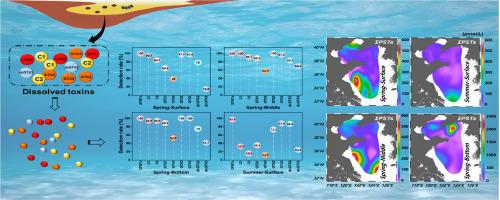Prevalence and distribution of dissolved paralytic shellfish toxins in seawater in the Yellow Sea and the Bohai Sea, China
IF 5.5
1区 生物学
Q1 MARINE & FRESHWATER BIOLOGY
引用次数: 0
Abstract
Paralytic shellfish toxins (PSTs) could be secreted by PSTs-producing microalgae or released by ruptured cells in seawater. In this study, the distribution of dissolved PSTs in the Yellow Sea and the Bohai Sea, China, was investigated by two cruises in April and July 2023. Seawater samples were collected from the surface, middle and bottom layers, and the profiles of PSTs were analyzed by liquid chromatography-tandem mass spectrometry (LC-MS/MS), and the spatial distribution characteristics of dissolved PSTs and their correlation with environmental factors were explored. Results showed that C1/2, GTX1/4, GTX2/3 and dcGTX2/3, were detected in seawater samples in both spring and summer, with the detection rates 100 % and 97.6 %, respectively. The total PST (ΣPSTs) concentrations ranged in 12 ∼ 590 pmol L−1, 9.3 ∼ 546 pmol L−1, 12 ∼ 2,452 pmol L−1, and not detected (nd) ∼ 188 pmol L−1 in seawater samples collected from the surface, middle and bottom layers in spring, and the surface layer in summer, respectively. Concentrations of PSTs markedly varied in the vertical water column in different sea regions. Generally, concentrations of ΣPSTs in the bottom seawater were higher than those in the surface and middle layers in the Bohai Sea and the North Yellow Sea, but no significant difference in the different water layers in the South Yellow Sea. In addition, concentrations of ΣPSTs in surface waters were much lower in summer than those in spring. In both spring and summer, dissolved PSTs in surface seawater were mainly distributed in the South Yellow Sea. These results indicate that PSTs were prevalent in the Yellow Sea and the Bohai Sea, of which the potential hazard to marine organisms should be highly concerned.

中国黄海和渤海海水中溶解性麻痹性贝类毒素的流行和分布情况
麻痹性贝类毒素(PSTs)可能由产生 PSTs 的微藻分泌,或由海水中破裂的细胞释放。本研究通过 2023 年 4 月和 7 月的两次航行,调查了中国黄海和渤海溶解性 PSTs 的分布情况。从表层、中层和底层采集海水样品,采用液相色谱-串联质谱法(LC-MS/MS)分析了溶解性 PSTs 的谱图,探讨了溶解性 PSTs 的空间分布特征及其与环境因子的相关性。结果表明,春季和夏季海水样品中均检出了 C1/2、GTX1/4、GTX2/3 和 dcGTX2/3,检出率分别为 100 % 和 97.6 %。春季在表层、中层和底层以及夏季在表层采集的海水样品中,总 PST(ΣPSTs)浓度分别为 12 ∼ 590 pmol L-1、9.3 ∼ 546 pmol L-1、12 ∼ 2,452 pmol L-1,未检出(nd)∼ 188 pmol L-1。在不同海区的垂直水体中,PST 的浓度存在明显差异。一般来说,渤海和北黄海底层海水中的ΣPSTs浓度高于表层和中层海水,而南黄海不同水层的ΣPSTs浓度无明显差异。此外,夏季表层海水中 ΣPSTs 的浓度远低于春季。在春季和夏季,表层海水中溶解的 PSTs 主要分布在南黄海。这些结果表明,PSTs 在黄海和渤海中普遍存在,其对海洋生物的潜在危害应引起高度关注。
本文章由计算机程序翻译,如有差异,请以英文原文为准。
求助全文
约1分钟内获得全文
求助全文
来源期刊

Harmful Algae
生物-海洋与淡水生物学
CiteScore
12.50
自引率
15.20%
发文量
122
审稿时长
7.5 months
期刊介绍:
This journal provides a forum to promote knowledge of harmful microalgae and macroalgae, including cyanobacteria, as well as monitoring, management and control of these organisms.
 求助内容:
求助内容: 应助结果提醒方式:
应助结果提醒方式:


